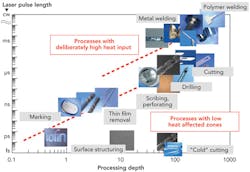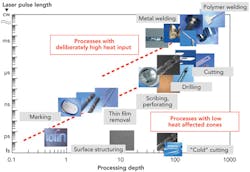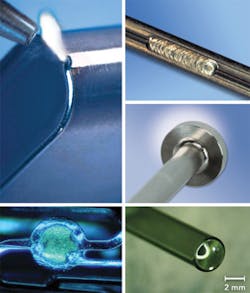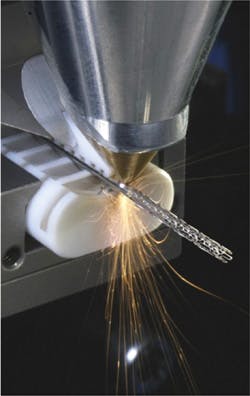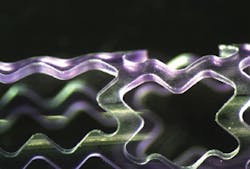Fiber lasers boost medical device production
Meeting material processing requirements for next-generation biocompatible components
Roland Mayerhofer, Dieter Mairhoermann, and Michael Mueller
For decades, lasers have been a well-established tool in the development and production of medical devices. Here, in parallel with other industrial application areas, fiber lasers are now gaining a significantly increased market share. For minimally invasive surgery and miniaturized implants, most of the next-generation products are getting smaller, requiring extremely material-sensitive processing — and laser technology is the ideal solution to meet upcoming requirements.
Most of the welding, cutting, engraving, or marking processes shown in FIGURE 1 are potential areas for the use of fiber laser concepts. There are three different types of fiber laser concepts applied in the development and production of medical devices: continuous wave (CW) modulated, pulsed/q-switched, and MOPA (master-oscillator-power-amplifier) configurations.
Fine laser welding
Lasers create high-strength and helium-tight welds in metals, glass, and polymers, where the laser welded joints can be used for high-temperature sterilization that exhibit pore-free surfaces without secondary finishing operations processes — crucial requirements for biocompatible components. Excellent laser beam quality, high pulse-to-pulse stability, and flexible pulse shaping are the preconditions for the finest seam and spot welding of biocompatible alloys.
For years, these requirements have been successfully accomplished with flash lamp-pumped Nd:YAG lasers. Now, fiber lasers are beginning to take over specific applications. Until recently, the lower-pulse peak power of fiber lasers has been a drawback in certain welding applications; CW fiber lasers were mainly used when applications required high throughput, narrow seam width, deep penetration, or CW operation due to metallurgical reasons. Pulsed Nd:YAG lasers offered benefits when applications called for low to medium throughput (especially for manual welding systems), spot sizes exceeding 0.1 mm (to bridge larger joint gaps), or when high-reflective materials have to be processed (requiring high peak power).
CW (modulated) fiber lasers must be focused down to very small spot sizes to achieve sufficient power density for generating a deep keyhole-shaped weld. This requires a very tight part fit (almost zero gap tolerance), with beam positioning more precise than is usually necessary in welding operations. To overcome this issue, the weld pool size must be enlarged while maintaining sufficient power density. A flexible way is to oscillate or wobble the laser beam with galvo- or piezo-driven mirrors at a speed of several milliseconds.
With the development of pulsed fiber lasers that produce several hundreds of watts average power and offer millisecond pulses, with a peak power of up to 10 times the average power level, it is now possible to achieve welding results similar to pulsed Nd:YAG lasers. The fiber laser offers higher wall-plug efficiency, easier integration into workstations, and highly flexible pulse shaping. These fiber lasers have the potential to substitute for flash-lamp-pumped solid-state lasers, even if the initial investment costs are currently still higher.
As shown in FIGURE 2, the most common laser application areas in manufacturing medical devices and instruments comprise welding operations are:
- Endoscopes
- Surgical instruments (knives and probing devices)
- Pacemaker housings and leads
- Wire stents
- Stent marker
- Vascular clamps
- Dental implants
Fine laser cutting
Laser fusion cutting, where an inert gas is used to expel molten metal from the cut area, is applied when flat or tubular shaped base materials must be cut into shapes to create medical devices with the least amount of post-processing. For decades, lamp-pumped Nd:YAG lasers with microsecond-pulse durations were used for these material processing operations. Fiber lasers are now taking market share from conventional solid-state lasers, offering the benefits of easier system integration, lower operating consumption costs, and better beam quality.
Most of the cutting applications for medical devices are in the thickness range of 0.2–1.0 mm. Because the cut geometries for medical devices are typically complex, fiber lasers used in medical device manufacturing are operated often in a modulated pulse regime. The peak power level must be significantly above CW level to reduce residual heat affects through more efficient material removal, especially in thicker cross-sections.
Fiber laser fusion-cutting operations are used during the manufacturing process of many different medical products:
- Surgical instruments (scull drills, knives, hip milling devices, bone saws)
- Cartridges (insulin dispensers)
- Needles
- Implants (stents, bone connectors)
The most well-known application is the production of coronary stents (FIGURE 3), made from different materials such as stainless steel, CoCr, or NiTi-shape memory alloys, where fiber lasers have been substituted for other solid-state lasers. Using high-peak-power, CW-modulated fiber lasers such as that shown in FIGURE 4 can cut Nitinol (NiTi50) up to a thickness of 1.0 mm with excellent quality and cutting speeds of up to 20 mm/s.1
Still, the as-cut quality of fusion laser-cut components is not quite suitable for direct implantation into the human body, so edges have to be rounded off and any melt deposit removed. On stainless steel and CoCr tube materials, the slag and dross removal on the inner tube walls can easily be removed by ultrasonic means. However, it is much more time consuming to remove unwanted melt deposition in medical implants made from NiTi-shape memory alloys where a high degree of manual work is involved, often leading to unacceptably high yield losses. More filigreed parts, for example neuronal stents with outer tube diameter below 200 µm, cannot be mechanically post-processed at all.
Laser “cold” cutting
The only chance to avoid the generation of large melt pools during the laser cutting process is by the use of ultrashort pulses delivered by a new type of fiber laser concept.2 Using pulse widths below 10 picoseconds (ps), material processing can be achieved with reduced heat affected zones and melt generation. Because of the low single-pulse removal rates of ultra-short pulses, economic cutting speeds of 1-10 mm/s are only possible when compensated by high pulse repetition rates in the range of 100-1000 kHz, leading to a very high degree of pulse overlap, typically 99.95%. A distribution of the pulse energy by fast scanning cannot be applied with that cutting application. A side effect of high degrees of pulse overlap is that heat can accumulate easily, and even pulses in the picosecond range can lead to unwanted distortion of the medical device. To produce medical micro-implants free of distortion, the pulse duration has to be further reduced by a factor of 10; this is accomplished through decreased thermal penetration depth of shorter pulses, and higher effectivity of the material removal process to minimize heat-affected zones.
Results of tube cutting trials with varied laser pulse durations indicate that cutting speed can be doubled when pulse widths of below 1 ps are applied.2 This leads to less heat input into the base material and it is obvious that it is more beneficial to use 500-800 femtosecond (fs) pulses for cutting applications with high pulse overlaps instead of typical laser pulses of 6-10 ps.
Even more obvious is the demand for ultrashort-pulsed lasers, when the next generation of medical implants is eventually approved for surgical implantation. Development departments at the large medical device companies are working on bio-absorbable materials, meant to dissolve after implantation within the human body to avoid the risk of re-clogging (stenosis) of vessels. The hottest candidates for such polymer materials are derivatives of polylactic and polyglycolic acids (PLGA), with melting temperatures in the range of 170-230 °C. FIGURE 5 shows a PLGA demonstrator tube, cut by a fiber laser with extremely high surface quality, showing a negligible heat-affected zone at the cut wall.
Summary
Fiber lasers are continuously substituting other laser concepts in medical device manufacturing. Former expectations, that high-peak-power welding and cutting applications will not be addressable by fiber lasers in the near future, had to be revised quite a while ago. Even femtosecond laser pulses of MW-peak power can be realized through fiber laser MOPA designs, and are a great tool for high-quality “cold” processing. Today, fiber lasers provide an ideal concept for most of the welding, cutting, and engraving applications within the production chain of medical devices. ✺
Roland Mayerhofer([email protected]), Dieter Mairhoermann, and Michael Mueller are with ROFIN-BAASEL Lasertech, Starnberg, Germany.
1. Mayerhofer, R., Mairhoermann, D., Müller, M., Röhner, M., Geiger, S., Holtz, R., Rüttimann, C.: “From CW to FS: Fiber Lasers for Medical Device Manufacturing“, Proc. ICALEO, 2012.
2. Mielke, M.: “High Energy Ultra Fast Fiber Laser Systems at 1552 nm for Industrial Applications”, FISC Workshop, Dresden, 2010.
More Industrial Laser Solutions Current Issue Articles
More Industrial Laser Solutions Archives Issue Articles
